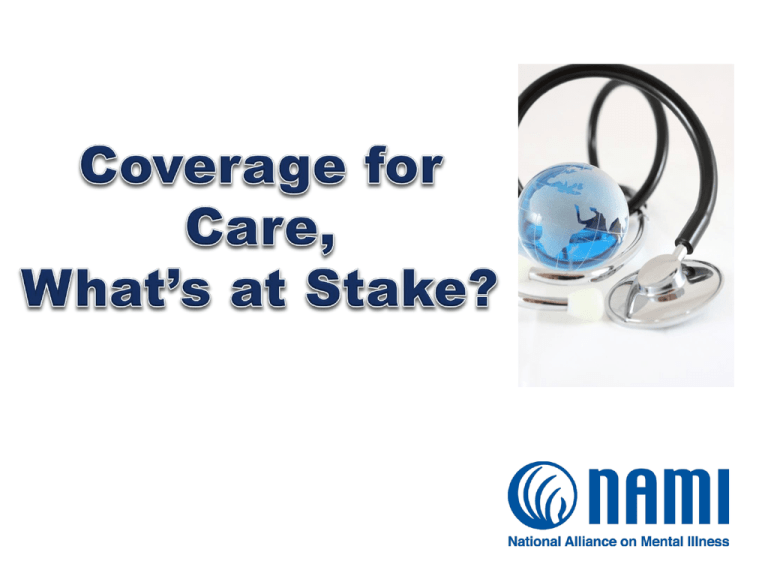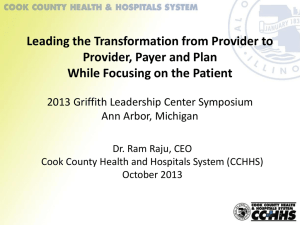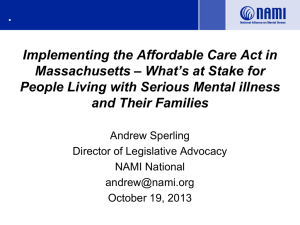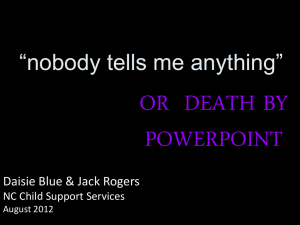Powerpoint
advertisement

Agenda Coverage for care overview Health insurance customer protections New Health Insurance Marketplace How will Medicaid change? What does it mean for our state? Call to action 50 million Americans Uninsured (2009) Financing Mental Health Care Other federal 5% Medicaid 27% Other state and local 18% Out of pocket 12% Medicare 8% Other private 3% Private insurance 27% Source: Garfield (2011) Mental Health Financing in the US: A Primer Kaiser Commission on Medicaid and the Uninsured Coverage for Care Federal/State Programs • Medicaid: – – – – Health finance program for the poor Only covers some lower income people Broad array of community mental health services Does not cover inpatient care age 22 – 64 • Children’s Health Insurance Program (CHIP) • Children not covered by Medicaid 100% - 200% FPL • May or may not offer full range of Medicaid services Coverage for Care Federal Programs • Medicare: – Seniors, people who received SSDI for >24 months – Limited array of mental health services – Medicaid beneficiaries with very low incomes may also qualify for Medicaid (dual-eligibles) • Veterans/Military: – VA health care: limited eligibility, but wide array of mental health services – TRICARE resembles private insurance Coverage for Care State and Local Public Systems • State and county mental health authorities • Serve people who fall through the cracks • Provide services not covered by Medicaid Private Health Insurance • • • • • Employer sponsored or purchased by individual/family Varied benefits Mental health parity requirements vary Limited array of mental health benefits typical Wider provider network New Health Insurance Rules Protect Customers • Children can’t be rejected for health coverage due to pre-existing conditions • Youth up to age 26 can be covered on parent’s health plan • No lifetime limits on benefits • Temporary high-risk pools • Plans may not withdraw coverage getting sick • Appeals process for denials • Plans must spend 80-85% on direct care for “My 21 year old daughter has had major depression since she was a child. We were very worried about health insurance when she wanted to leave home. Now she can stay on our health plan until she is 26.” The new health law allows parents to keep adult children on their plan until age 26. Uninsured Adults with Mental Illness Uninsured 11 million 24% Covered 34.5 million 76% US: Total of 45.6 million adults with mental illness Source: SAMHSA, National Survey of Drug Use and Health, 2011 New Coverage Options • Health Insurance Marketplace: private coverage • Individuals • Small Employers (SHOP) • Medicaid expansion: 0 -138% FPL • Parity required: – All individual and small group plans – All Medicaid benchmark plans – Traditional Medicaid managed care plans • Care coordination/ integration strategies Health Insurance Marketplace = Health Insurance Exchange Goals: Good health coverage at affordable cost • Regulates: “Qualified Health Plans” “Essential Health Benefits” • Rates Qualified Health Plans Source: Mass Health Connector www.mahealthconnector.org/ • Unified online application for exchange, Medicaid, CHIP • Toll-free telephone hotline • Website to compare health plan information • Standardized format to present health benefit options • Electronic calculator to figure actual cost of coverage Qualified Health Plans (QHP) Only Qualified Health Plans allowed in Health Insurance Marketplaces – Must provide Essential Health Benefits – Insurer must meet requirements: • In good standing with the State • Offers at least: – One silver and – One gold plan • Offers the same premium for qualified health plans inside and outside the Exchange Source: Illinois Department of Insurance Health Insurance Marketplace Incentives • INDIVIDUALS – Tax Credits for Premium Subsidies – Cost-Sharing Subsidies – Reduced OOP limits, annual cap $6,350 (premium + deductible) • SMALL BUSINESS – Small business Health Options Program (SHOP) – Help small employers enroll employees in qualified health plans – Small Business Tax Credit Individual & Employer Mandates • Individual responsibility to buy insurance – Penalties of $95 in 2014, • $325 in 2015, • $695 in 2016, OR – Percent of household income • 1% in 2014, • 2% in 2015 and • 2.5% in 2016 and beyond – Exempts individuals below the tax filing threshold • Employer penalties Beginning in 2015 – Applies to employers with 50 or more employees – Penalties from $2,000 to $3,000 per employee, – If employer fails to offer coverage or offers bare bones coverage Eligibility and Financial Assistance Question: Do the new rules help me get Medicaid? Answer: IF your state expands Medicaid and IF your income is at or below 138% of Federal Poverty Level, then yes. Question: Are you eligible for government help buying insurance? Answer: The government will help pay part of premiums and out-of-pocket costs for people with incomes between 100 percent and 400 percent of the federal poverty level. Family Size 100% FPL 138% FPL 1 $11,490 $15,856 2 $15,510 $21,404 3 $19,530 $26,951 4 $23,550 $32,499 Family Size 100% 400% 1 $11,490 $45,960 2 $15,510 $62,040 3 $19,530 $78,120 4 $23,550 $94,200 Essential Health Benefits Outpatient clinic services Prescription drugs Emergency services Rehabilitative & habilitative services Hospital care Maternity, newborn care Mental health, behavioral health, substance use care Laboratory services Children’s services, dental & vision care Wellness, disease management Benefit Continuity Essential Benefits Package Source: Sommers, B.D. & Rosenbaum, S. (2011). Health Affairs. Presented by S Fields, NAMI 2011. “I had a 4.0 GPA in school but I dropped out after my insurance stopped covering my medication. I started hanging out with the wrong crowd and self-medicating just to get away from the pain and confusion. Now I’m trying to get back on track, but every day is a struggle.” The new health law requires Medicaid expansion and health insurance marketplace plans to provide medication and lab work, but advocacy is needed. Expanded Medicaid Eligibility Now Categorical + Financial Criteria • • • • • Pregnant women Infants/Children Families with dependent children Aged, Blind, Disabled Assets and other income 2014 Financial Criteria Only •Single adults under 65: •Incomes up to 138% of the Federal Poverty Level • Ag ed Dis abl ed • Fa mil Infants/Children ies ith de pe nd ent chil dre n “I was married and working, but stopped taking my medications because I didn’t feel sick. Things went downhill fast. My wife left me, I lost my job and had to move back in with my parents.” • The new health law will provide a second chance in states that expand Medicaid. Anyone with an income is below 138 % FPL will be able to enroll in Medicaid and get treatment. It will also be easier to return to work and get private insurance. • NEW DONUT HOLE? In states that do not expand Medicaid will people with incomes below 100 percent FPL will get federal financial help to buy a private plan? Medicaid Expansion Any uninsured ≤ 138% FPL – 100% federal match for newly Medicaid eligible: 2014 – 2016 – Reduced gradually to 90% federal match, 2020 forward Source: The Advisory Board Company, July 26, 2013 In-State Update Prepare NOW for New Coverage www.healthcare.gov • Enrollment assistance - 24/7 call center – Toll free: 1-800-318-2596 – TTY/TDD: 1-855-889-4325 for assistance – English, Spanish, 150 languages Call to Action • Contact your legislator today! Call or email! – To find their contact information: [link] – Schedule a visit in the district • ASK: – Health care coverage will help people with mental illness recover and contribute to their communities. – Can I count on your support to expand good, affordable health coverage to all households with incomes from 0 to 138 percent of poverty? – Can I count on you to advocate for mental health coverage on par with medical/surgical care? Presenter name Title Contact information





